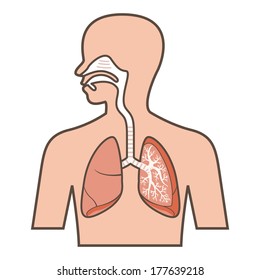Respiratory System Function
Your respiratory system allows you to laugh,talk, and sing.The respiratory system
brings oxygen into your body and gets rid of carbon dioxide.
Your cells need oxygen to grow,work,and keep your body working.
When cells do their jobs they give carbon dioxide.
brings oxygen into your body and gets rid of carbon dioxide.
Your cells need oxygen to grow,work,and keep your body working.
When cells do their jobs they give carbon dioxide.
Organs used in the System:
Nose: The moisture in the nose helps to heat to heat and humidify the air,making the amount of water vapour entering the lungs.This prevents the air from drying out the lungs and other parts of the respiratory system.
Pharynx:The pharynx is like a passage way for food it also takes the air in and leads to your stomach and lungs.
Larynx: The larynx is a strong but a flexible segment of the respiratory tract connecting the pharynx and the trachea in the neck.it plays an important role in the the respiratory tract by letting air to pass through it while keeping food and drinks from blocking the air way.

Trachea:The trachea is a wide, hollow tube that connects the larynx to the bronchi of the lungs. It is an integral part of the body's airway and has the vital function of providing air flow to and from the lungs for respiration.
Bronchi: The bronchi is known as a bronchus are extensions of the windpipe that shuttles air to the lungs and from the lungs.they are part of the conducting zone of respiratory system.
Lungs: The lungs in the respiratory system allows us to breathe.Our lungs bring oxygen into our body called inhalation and send carbon dioxide out called exhalation.The exchange of oxygen and carbon dioxide is called respiration.
Interaction With Other System
Our Respiratory system works best with our circulatory system,as Oxygen taken in
from the respiratory system moves into blood vessels that then circulate oxygen-rich blood to tissues and cells.
Analogy Explanation
The tree branches separate out in branches just like the bronchi does from the larynx.
The tree roots are like the larynx they connect to the tree trunk.
- The bronchi separates out like branches
- Form the shape of upside down lungs
the tree trunk is like the trachea it supports the tree like the trachea does to the lungs.
By: Naima,Manar,and Hamzah
SOURCES
Cervantes,Alejandra.¨RespiratorySystemAnalogy¨.Prezi.Prezi.com.Prezi.com.Dec 20,2014/1y15iphpwwx/respiratory-system-analogy/03/04/2020
Adrenal Fatigue Solution
Giselle Bee on Prezi
Shutterstock
